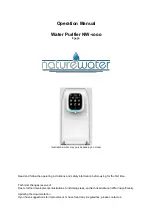
35
The chapter 'Safety instructions' must be heeded.
Important - a proper and timely disposal of the separator in-
sures that the system operations properly and as designed.
Grease separator disposal work should be handled by a li-
censed disposal company. Disposal of the separator should
take place during off hours as a separator with open covers
will release unpleasant odours.
Disposal should take place before the storage capacity of
the sludge collection area (which is half of the sludge storage
volume) and the grease collection area are exceeded. Under
normal circumstances a monthly complete disposal as well
as internal cleaning of the separator is sufficient. After dis-
posal and cleaning, the separator should be completely filled
(to outlet level) with water. In the case that large volumes of
sludge or grease are collected quickly inside the separator,
the disposal intervals should be shortened respectively. The
following measures should be taken when disposing a grea-
se separator:
Complete disposal and internal rinsing /
cleaning of the separator
Automated separators with disposal and cleaning systems
should be checked for proper system operation
Any remaining solids, debris or deposits should be removed
Cleaning of the odour tight cast iron manhole covers as well
as inspection of the cover's sealing gasket
If a sampling chamber is present it should also be sprayed
down and cleaned
After disposal and cleaning is complete the entire separator
should be completely refilled with water.
Disposal
Loosen the locking bolts on the separator's manhole cover(s)
using the included hand tool
•
Remove the manhole cover(s)
•
Insert vacuum disposal hose from the disposal vehicle to
the base of the separator and suction out entire contents
•
Spray down interior of separator and remove any solids or
deposits
•
Completely fill separator with water
•
Replace manhole cover(s) - check condition of manhole
cover and gasket
•
Tighten bolts on manhole cover(s)
•
Enter disposal date and information in log book.
7. Disposal
















































